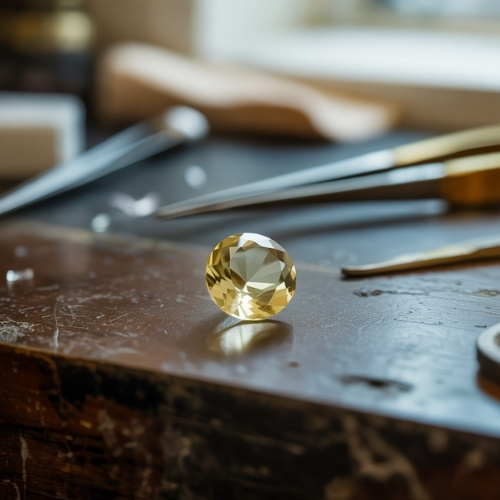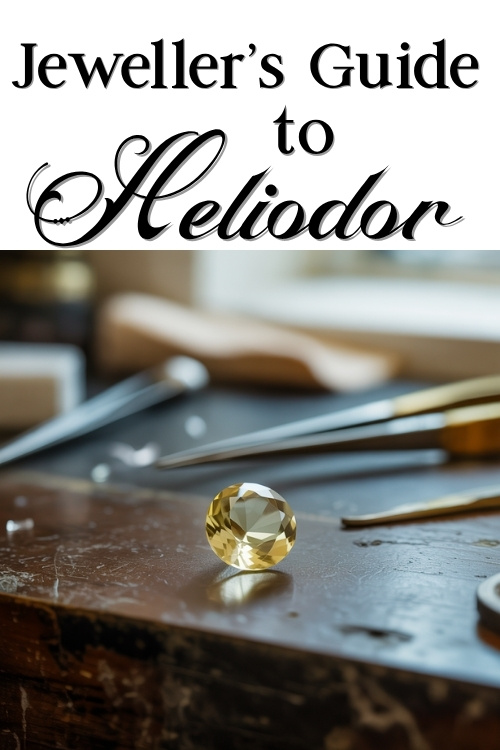Estimated reading time: 4 minutes
Heliodor carries the warmth of sunlight captured in gemstone form, its golden hues span from soft lemon to rich honey, offering a clear, luminous alternative to more common yellow gems. For jewellers and designers seeking a rarer gem with an uplifting tone, heliodor brings steady brilliance without shouting.
Jump to:
Basic Identification Information
Name & Synonyms:
Heliodor, golden beryl, yellow beryl
Species:
Beryl
Colour Range:
Yellow, from greenish-yellow through orangy and brownish yellows.
(Some definitions restrict “heliodor” to well-saturated golden yellow tones.)
Refractive Index:
1.560 – 1.600
Birefringence:
0.005 – 0.009
Optical Sign:
Uniaxial –
Pleochroism:
Weak to moderate, 2 colours
Typically shows brownish yellow and lemon yellow
Specific Gravity:
2.67 – 2.90
Fluorescence:
Inert
Lustre:
Vitreous (glass-like)
Clarity:
Type I
These gems are usually eye-clean
Gems Often Mistaken For:
Citrine, yellow sapphire, chrysoberyl
Mohs Hardness:
7.5 – 8
Wearability:
Very good
Birthstone:
Heliodor isn’t considered a modern or traditional birthstone
Spotting Synthetic (Lab-Grown) Heliodor
While lab-grown heliodor is technically possible through flux or hydrothermal growth methods, it’s not commercially produced. The cost and complexity of synthesis far outweigh the demand for this lesser-known gem, making synthetic heliodor virtually nonexistent in the jewellery market.
For jewellers, this means you’re highly unlikely to encounter a lab-grown heliodor in practice. If a stone raises suspicion by looking too perfect, it’s far more likely to be a treated natural gem or a misidentified lookalike (like yellow sapphire or citrine) than a true synthetic.
Common Treatments
Most heliodor is sold untreated.
Some stones undergo heat treatment and/or irradiation to intensify the yellow or remove greenish tints; these treatments are generally stable. Heat-treated examples may show altered inclusions or an unnaturally even colour when viewed under magnification, which can help differentiate them from completely natural material.
Durability & Setting Considerations
Heliodor is a durable choice for many types of jewellery thanks to its reasonably high hardness and low tendency to fracture. It has indistinct cleavage, but sharp blows, especially to facet edges or corners, can cause chipping.
The gem is stable under normal light and temperature, though jewellers should take care when working with nearby heat sources during setting or repair. Avoid sudden thermal shock and exposure to strong acids or solvents during maintenance.
For design work, heliodor is adaptable: reflective backings can boost brilliance in lighter stones, while deeper tones benefit from open, light-friendly settings. Prong settings show off the gem well, but bezels add protection, making them preferable for rings or bracelets.
🛍️ Explore our selection of pre-owned Heliodor Gemstones for your next jewellery creation.
Care Instructions
Cleaning:
Use warm, soapy water and a soft brush for regular maintenance. Ultrasonic cleaners are usually safe for untreated heliodor, but avoid them if the stone has noticeable inclusions or if you know it has been heat-treated. Steam cleaning is not recommended.
Storage:
Keep heliodor separate from harder gems (like sapphire or spinel) to prevent abrasion. Store wrapped individually or in soft compartments to avoid knocks and surface scratches.
Daily Wear:
Heliodor performs well in everyday jewellery, but mindful handling is still wise, especially in high-contact pieces. Avoid wearing during rough manual activities to prevent nicks to facet edges from accidental impacts.
Market & Ethical Notes
Heliodor is sourced from several countries, including Brazil, Namibia, Madagascar, Ukraine, and the USA, typically from pegmatitic environments where beryl forms in sizable crystals. Many of the mines that produce
Clean, larger stones are less common and therefore carry a premium.
Ethically sourced heliodor is available, and many sellers offer untreated material.
🔗 Learn more about the ethical and environmental story behind Reclaimed and Recycled Gemstones.
Symbolic & Spiritual Meanings
Heliodor is traditionally associated with the energy of the sun. Clarity, vitality, confidence, and personal power.
It’s linked to the solar plexus chakra, reinforcing will, self-worth, and the courage to act. Crystal healing practitioners often position it as a gemstone that supports empowerment and optimistic intention.
🔗 Dive deeper into Heliodor’s Symbolic & Spiritual Meanings
Etymology
The name heliodor derives from the Greek helios (sun) and doron (gift): literally, “gift of the sun.” The term was popularized in the early 20th century by German gemmologists captivated by its warm yellow glow. Though less prominent than its beryl relatives like emerald or aquamarine, heliodor has long held a quiet appeal for those seeking golden luminosity with substance.
🔗Curious about how heliodor was viewed in ancient cultures? Explore its fascinating myths and legends (coming soon)
📌 Save this jeweller’s guide to heliodor for quick reference next time you’re working with this stunning gem.


